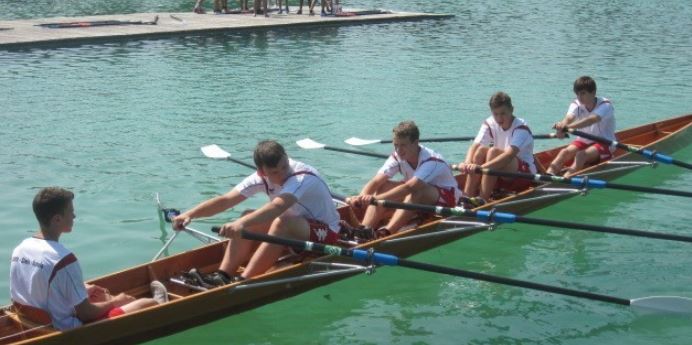At the Vogalonga 2019, I met a French Rowing Crew who had 2 visual impaired athletes in their team. I was amazed how effective their teamwork was and how much fun the team had while setting up their rowing shell.
FamilyConnect®a website for parents with visual impaired children recommends rowing as a prime sports for their kids. Read what they have to say:
The Benefits of Rowing Without Sight
Visually impaired rowers: Credit ORvO.de
If you’ve never set foot in a rowing shell (the term used for a boat), it may surprise you to hear that rowing is a sport that lends itself quite naturally to adapt to individuals who are blind and visually impaired. Ironically, sighted rowers, especially those rowing in four and eight-person shells, are very familiar with the benefits of rowing without sight. In fact, one of the most popular drills on rowing teams is called, “Eyes-Closed Rowing Drill.” For many, it’s considered one of the most productive exercises.
The drill requires all rowers in the boat to forget all their bad habits that involve their eyes: looking out at their oar, looking at the oar of a team member’s oar, looking behind them to check the timing of the oars behind them, looking at their coach while they give orders. With their eyes closed, they’re permitted to mute all the visual world’s distractions and just row; just listen to the sound of the blades as they pierce the water; just feel the flow of the water underneath the hull; just sense the momentum of the persons in front and behind you and blend with them. What does this tell you? The widespread appeal and productivity of this drill tell us one thing: you do not need your vision to row well. In fact, sometimes, your vision can be a handicap.
 Visually impaired Athlets: Racing in Bosten Credit Cleveland19.com
Visually impaired Athlets: Racing in Bosten Credit Cleveland19.com
Rowing in a single or double (single rower or two rowers in a shell) is a different scenario, as you are typically without a third party—the coxswain—that is steering. In this case, one of the rowers will need their vision to direct the boat. But, for our purposes, we are speaking of the team sport of rowing, a sport that is growing rapidly across the country and making strides to be quite easily adaptable to individuals with physical disabilities and visual impairments or blindness.You’re sitting on the hard wooden seat, four seats from the front of the boat and the coxswain. You’re leaning back from the hip, forming a 45-degree angle. Your hands, gripped around the handle of the oar, tightly without clenching, are pressed firmly against your abdomen, tucked just below your lowest rib. Your legs, outstretched in front of you, secured in their shoes, are in gear, ready to press with all your might when your coxswain makes the call.
Rowing for Blind Athletes
This is your first time out on the water as a member of your city’s nonprofit adaptive rowing program. Yes, you know you’re fortunate to be living in an area, that provides clubs and organizations for adaptive rowing training and racing programs for blind and visually impaired athletes.
Imagine your third week in the boat. You earned your seat fair and square after a series of endurance tests, and your first race is next week. You listen, waiting to hear the next order from your coxswain, as you complete the drill.
“Arms away… pause,” she calls out.”Bodies over… pause. Half-slide… pause. Controlled slides, and… Row.” Your blade grabs the water, feels the resistance, and then plows through, one long steady press. Your legs burn, but the second you feel the fruit of your labor—the water gliding fast underneath the hull—your body thanks you.
Imagine: It’s a good feeling, using your body to push your boat and your teammates closer to the finish line with each stroke. Feel how the boat cuts through the river.
Tips for Getting Connected
- Contact the boathouses in your area and ask them if they have a program established for adaptive rowing.
- Ask the captain if there is a dedicated person for the disabled rowers
- If they do not, don’t be discouraged. They may be able to direct you to a boathouse in the area that does.
- Or, they may have the resources and personnel to start a program to provide volunteer coaching or guidance as you start your training.
- Use your hands and imagination to understand the equipment and the dynamics of the rowing technique.
Remember, all you need to start a program is one rower, a borrowed boat, and one volunteer.
Clubs can offer adaptive rowing programs:
- Make sure your club is willing to install a rowing program for adaptive rowers. Not all athletes attracted to adaptive rowing are going to feel immediately comfortable going out on the water. This is actually true for all rowers, sighted or visually impaired.
- Define a “godfather” for the adaptive crew who feels responsible.
- The first step of acquainting oneself with the sport is through a walk through the boat house. Explain the equipment and let the athletes feel the oars, boats, riggers etc.
- Explain well the rowing commands, let the crew repeat them, and make sure they know exactly the effect of applying them.
- Use a coxed quad, best a touring quad with 2 visually impaired rowers only when you go to the water the first time.
“This sport is one of the best full-body workouts, it can be an independent or team sport, and it’s without a doubt, a sensational way to exercise. Most importantly, vision is not required to participate, improve, enter official racing events, and succeed. Unlike so many other sports, there is no part of rowing that requires you to see what you’re doing. It’s about listening to an internal rhythm, locking into that pace, matching seamlessly those in front and behind you, dropping the blade at the same spot at every stroke—the point of optimal leverage—and kicking like hell.”








This Post Has One Comment
Lovely article as I have a 14 year old, visually impaired daughter that started rowing this year and LOVING EVERY GRUELING MINUTE!! She attends a main stream school in East London, South Africa.